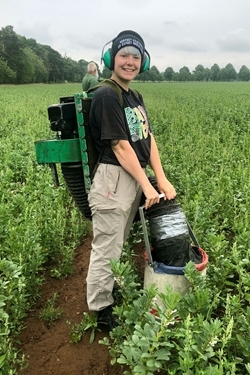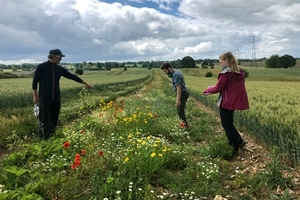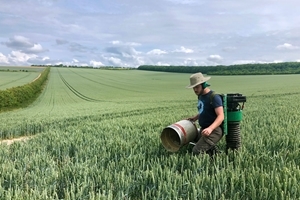By Jemma Gibson, GIS Placement Student
 The D-Vac is a machine that has been used for sampling insects on the Trust’s long-term study areas since before I was born. It has a petrol motor, with a large fan and a tube for suction. It’s a heavy, smelly, dirty machine but it does the job. Insect sampling is not the most glamourous job, but many people underestimate the value of the work of our entomologists.
The D-Vac is a machine that has been used for sampling insects on the Trust’s long-term study areas since before I was born. It has a petrol motor, with a large fan and a tube for suction. It’s a heavy, smelly, dirty machine but it does the job. Insect sampling is not the most glamourous job, but many people underestimate the value of the work of our entomologists.
Usually the Farmland Ecology Unit will complete the D-Vac sampling needed for our research. The GWCT has several sites around the country that are normally sampled, including the Sandringham Estate in Norfolk and two of our long-term study areas in Leicestershire and Sussex. COVID-19 threatened to cancel this fieldwork – D-Vac sampling requires a team of two people, in close proximity, and our schedule required that team to travel the width and breadth of the country. Luckily enough, there was one team left at the GWCT that could take on the challenge, two students who didn’t know what they were signing up for.
Our work took us to seven sites, over five weeks, and had us travelling 1,500 miles. Due to COVID-19 we couldn’t stay at hotels or go to the pub after a long day’s work. Instead we stayed in visitor accommodation at the beautiful Sandringham, a disused hunting lodge, a sauna-like caravan, or, even worse, driving all the way home at the end of a long day!
I’ve lost count of how many samples we’ve taken – it was a lot! The work was hard, having the D-Vac strapped to your back, especially when it’s 28 degrees and 95% humidity. There is something very satisfying, however, about filling a hundred bags with bugs and going to bed with aching shoulders.
 This year it has been challenging to get all the fieldwork done: normally this work would be done by several teams and avoid packing all the fieldwork into a short time span. However, when COVID threw a spanner in the works, the research team had to quickly figure out a plan to get the job done. Matthew and I were trained on the D-Vac protocols and then let loose on the farmlands of the UK. We had to take responsibility for getting the job done, representing the GWCT at our partner sites and working harder than we ever have before in difficult conditions.
This year it has been challenging to get all the fieldwork done: normally this work would be done by several teams and avoid packing all the fieldwork into a short time span. However, when COVID threw a spanner in the works, the research team had to quickly figure out a plan to get the job done. Matthew and I were trained on the D-Vac protocols and then let loose on the farmlands of the UK. We had to take responsibility for getting the job done, representing the GWCT at our partner sites and working harder than we ever have before in difficult conditions.
As tough as this field season has been, it really gave us an opportunity to show what we could do. For the first nine months of my placement with the GWCT, I spent the majority of my time at a desk, learning the GIS technical side of conservation, whereas the last two months I have been out and about seeing the true value of farmland conservation.
 When I first arrived at the GWCT I hadn’t grasped the true concept of the work that we do here. I was confused at why everyone is so obsessed with the grey partridge – yes, it’s a cute little bird, but what about all the rest? Once you’re out on farms and seeing a covey with day-old chicks waddling up the track, you start to see the attraction. It’s not just about the partridge, with the D-Vac work you can see the whole picture. We assess the habitat suitability and the chick food availability. I spoke to the gamekeepers and landowners; they really are passionate about the beautiful synergy of the farmland ecosystem.
When I first arrived at the GWCT I hadn’t grasped the true concept of the work that we do here. I was confused at why everyone is so obsessed with the grey partridge – yes, it’s a cute little bird, but what about all the rest? Once you’re out on farms and seeing a covey with day-old chicks waddling up the track, you start to see the attraction. It’s not just about the partridge, with the D-Vac work you can see the whole picture. We assess the habitat suitability and the chick food availability. I spoke to the gamekeepers and landowners; they really are passionate about the beautiful synergy of the farmland ecosystem.
After all the sweat and stress and bruises, I am so glad that I took this opportunity. Travelling the country, seeing the beauty of farmland conservation and the depth of knowledge and hard work that it takes to pull this off has made me appreciate the dedication of both those on the ground and the research team so much more. I am happy and proud to play a part in this.